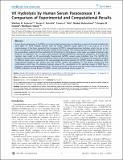VX Hydrolysis by Human Serum Paraoxonase 1: A Comparison of Experimental and Computational Results
Author(s)
Peterson, Matthew W.; Fairchild, Steven Z.; Otto, Tamara C.; Mohtashemi, Mojdeh; Cerasoli, Douglas M.; Chang, Wenling E.; ... Show more Show less
DownloadPeterson-2011-VX Hydrolysis by Hum.pdf (239.9Kb)
PUBLISHER_CC
Publisher with Creative Commons License
Creative Commons Attribution
Terms of use
Metadata
Show full item recordAbstract
Human Serum paraoxonase 1 (HuPON1) is an enzyme that has been shown to hydrolyze a variety of chemicals including the nerve agent VX. While wildtype HuPON1 does not exhibit sufficient activity against VX to be used as an in vivo countermeasure, it has been suggested that increasing HuPON1's organophosphorous hydrolase activity by one or two orders of magnitude would make the enzyme suitable for this purpose. The binding interaction between HuPON1 and VX has recently been modeled, but the mechanism for VX hydrolysis is still unknown. In this study, we created a transition state model for VX hydrolysis (VXts) in water using quantum mechanical/molecular mechanical simulations, and docked the transition state model to 22 experimentally characterized HuPON1 variants using AutoDock Vina. The HuPON1-VXts complexes were grouped by reaction mechanism using a novel clustering procedure. The average Vina interaction energies for different clusters were compared to the experimentally determined activities of HuPON1 variants to determine which computational procedures best predict how well HuPON1 variants will hydrolyze VX. The analysis showed that only conformations which have the attacking hydroxyl group of VXts coordinated by the sidechain oxygen of D269 have a significant correlation with experimental results. The results from this study can be used for further characterization of how HuPON1 hydrolyzes VX and design of HuPON1 variants with increased activity against VX.
Date issued
2011-05Department
Massachusetts Institute of Technology. Computer Science and Artificial Intelligence Laboratory; Massachusetts Institute of Technology. Department of Biological EngineeringJournal
PLoS One
Publisher
Public Library of Science
Citation
Peterson, Matthew W. et al. “VX Hydrolysis by Human Serum Paraoxonase 1: A Comparison of Experimental and Computational Results.” Ed. John Parkinson. PLoS ONE 6.5 (2011) : e20335.
Version: Final published version
ISSN
1932-6203